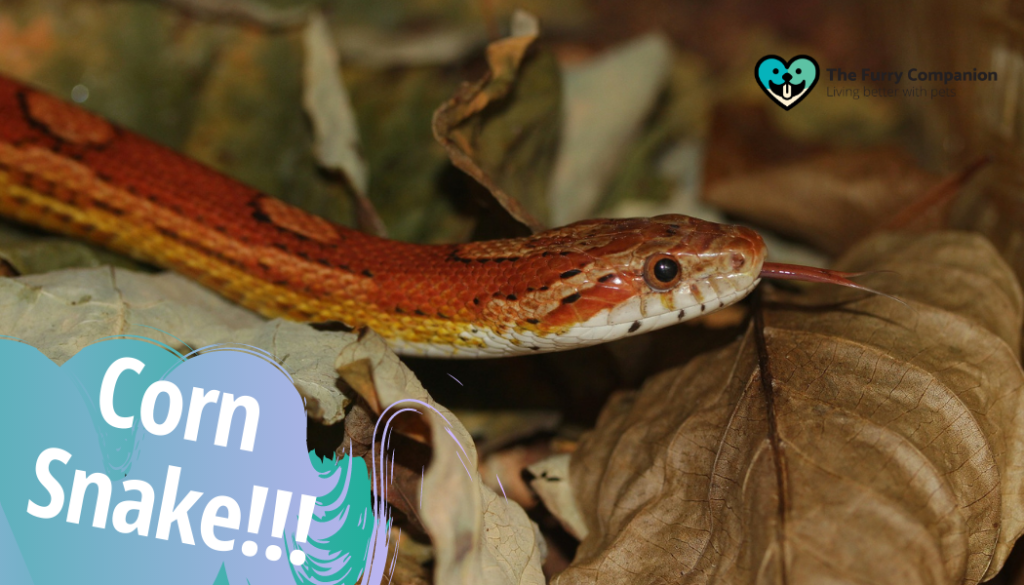These days, it seems everyone is getting the most exotic pet possible. The corn snake is among the newest addition to this growing list. Named for their tendency to slither around corn barns and wait for unsuspecting rodents, this small and docile snake breed has acquired a reputation for being one of the easiest snakes to handle. This makes them a suitable option for beginner reptile owners.
But before you jump to the latest craze, remember that getting a corn snake – or any pet for that matter – requires a lifelong commitment. At The Furry Companion, we believe that owners should take responsibility for their pets throughout their life. When the novelty or cuteness fades, you have to put in the work and stay by your pet in sickness and in health.
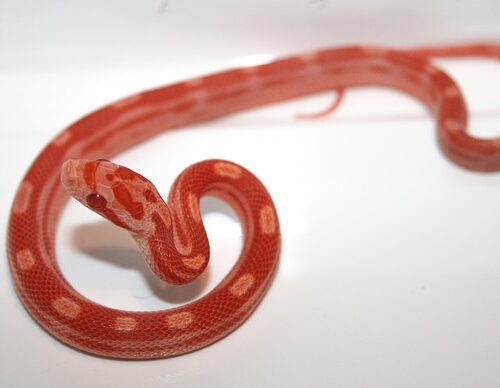
To see if you’re up to the task, we compiled a list of facts you need to know, how to take proper care of your scaly pet, and provide it with a supportive environment that can extend its life. By the end of this read, we hope that you can make an informed decision about choosing a corn snake as your new companion for life.
Table of Contents
The Perfect Environment
A pet snake should have a dedicated habitat called a vivarium that mimics its natural environment as closely as possible. Unlike a dog or a cat that can roam around freely, a reptile in captivity can only prosper in a controlled environment. Check this terrarium for your corn snake.
“The corn snake is a beautiful and undemanding captive. With proper husbandry, it may be easily raised and bred by even the most uninitiated herpetoculturists. Corn snakes do not require expensive, specialized husbandry equipment or complex diets for proper care,” William G. Griswold, DVM said in a journal article.
Tank Size and Temperature
The first factor is the tank size. Your snake should have enough room once it reaches its full length. Corn snakes may grow to as long as 150 cm, so a snake of this length needs a vivarium that’s at least 150 cm long, 50 cm wide, and 50 cm deep, or you can select a 20- to 40-gallon tank. You may start with 10-gallon tanks with smooth, waterproof sides for hatchlings and increase the size as it grows.
Like most snakes, corns are crafty pets that are always searching for a way out of their enclosures. They can and will exploit all openings, so it’s best to find a tank with latching or sliding lids with a lock on the top.
Temperature is another critical factor to consider since your new pet is a cold-blooded animal. Corn snakes do well in temperatures of 22–32° Celsius or 72–90° Fahrenheit. The vivarium should have a heat source like an incandescent lamp installed in one zone so that your snake can obtain the heat it needs.
Meanwhile, the other end of your cage should be cold. This thermal gradient allows your snake to slither around and regulate its body temperature as needed.
Humidity and Lighting
In terms of humidity, set the hygrometer within the 40–50% range to keep their respiratory system and skin healthy.
Cage lighting is also crucial since reptiles use natural daylight for their day-to-day patterns. Your snake can also benefit from exposure to ultraviolet A (UVA) radiation, which may be useful in encouraging social and reproductive behaviors.
To make your pet feel at home, accessories can entertain your snake. You can put plants, forked branches, and small boxes inside the vivarium where your pet can climb and curl around.
Meanwhile, you can use organic soils and aspen shavings topped with dry leaves for the floor covering or substrate. As much as possible, avoid pine and cedar shavings or any other rough materials that can irritate your reptile and cause stomatitis.
Snake Den
To complete the set-up, your pet needs a hiding spot. In the wild, corn snakes take refuge in rodent burrows or the space under logs, but you can use a makeshift container, a small pot, or even toilet paper tubes. Ensure that it’s small enough to make your pet snake feel secure but not large enough that it’s visible. Buy this terrarium design for your corn snake.
What’s in a Corn Snake Diet?
The main component in a captive corn’s diet is fresh, frozen, thawed mice. On the other hand, newborns prefer lizards, although they usually tend to skew in favor of mice later on.
Hatchlings and juvenile snakes should be fed pinkies or small prey every five to seven days, while mature adults should eat on a weekly or monthly basis.
While it’s essential to take note of what or when you’re feeding them, it is equally important as well where you’re feeding your snake. If you have more than one snake, they should eat separately to avoid fighting over the same food. You can move the feeding ground to a bare location to reduce the risk of ingesting the substrate.
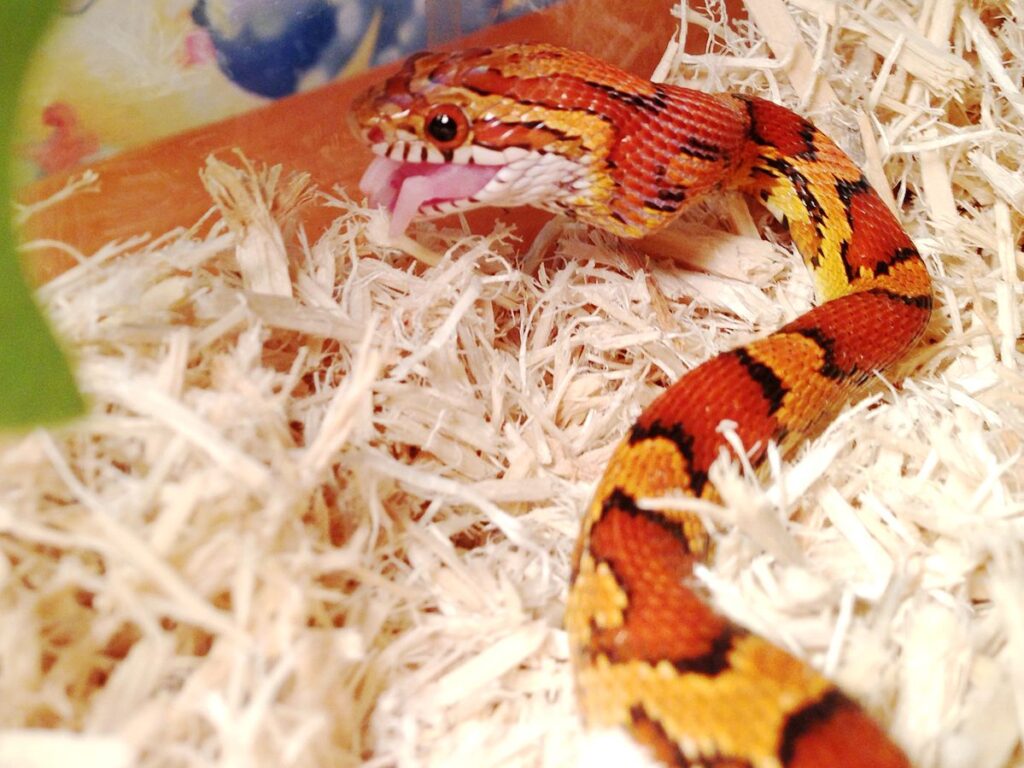
It’s best to avoid feeding live prey since mice can carry parasites or injure your pet during the struggle. To ensure your snake gets the nutrients it needs, consider buying calcium supplements which you can lightly sprinkle over its food.
A dish filled with fresh water should always be available and should get a daily refill to keep your snake hydrated. Snakes sometimes use their water for excretion purposes, so clean and refill the dish immediately when this happens.
Proper Handling
Corn snakes don’t get easily agitated, and they can get used to human handling, but only after a certain period.
To pick up your snake, place your hands in an area somewhere near the head and another near the tail. You can hold your snake for a maximum of 10–15 minutes. Make sure that you don’t go beyond that period since it might cause its temperature to fluctuate. You can jump-start this step by allowing your snake to get used to your presence first. Make sure to check on your snake consistently, at least two to three times a week.
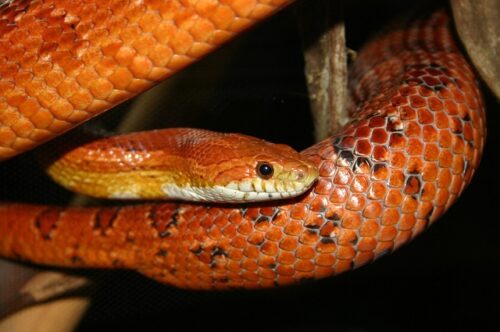
Maintaining the Health of a Corn Snake
Snakes shed their old skin, which is a fascinating process to watch. Before this occurs, you might notice its eyes getting cloudy and its skin looking dull. Your snake may hide in burrows for some time then use objects inside the enclosure to remove its old skin. Give your corn snake this reptile vitamins.
In terms of sickness, corn snakes have a generally strong resistance against disease, but they’re not invincible. Most of the medical conditions they develop are a result of improper care, environment, and diet. If you notice anything unusual regarding your pet’s health, call your vet immediately.
Without adequate regulation of the humidity and temperature in the vivarium are, your snake can develop respiratory disorders and immune suppression. Snakes should undergo regular checks for parasites like mites that usually hide around the eyes or under the chin. Other diseases to look out for are mouth rot and metabolic bone disease.
Females are also highly vulnerable, especially after giving birth. “Dystocia or egg binding happens when the female snake is unable to pass her eggs. It is a reasonably common problem in reptiles and can be life threatening. It is caused by a variety of factors,” explains Rick Axelson, DVM. Common among reptiles, dystocia happens due to poor husbandry.
Remember: a healthy snake is alert with bright, clear eyes and flicking tongue. There should be no parasites, wounds, lumps, or scars on its skin. Check its mouth for any signs of injuries or oral discharge and listen closely to its breathing for any symptoms of respiratory problems.
A corn snake has an average life expectancy of 6–8 years, but corn snakes in captivity that receive excellent care can live up to 20 years, primarily due to the absence of predators.
Are Corn Snakes Affectionate?
After all the time and money you spent to take good care of your pet, you might wonder if your pet snake can appreciate these efforts and reciprocate your feelings.
We hate to break it to you, but snakes feel only the most basic emotions related to survival and reproduction. Like most reptiles, snakes have enough mental and emotional capacity to feel hungry or threatened, but nothing too complicated as love.
It was an old belief that snakes exhibiting behaviors like tongue-flicking and wrapping themselves around your hand or shoulders were their unique way of showing affection. However, science tells us that these are ways snakes make sense of their world in captivity and not the gentle kisses or signs of love you hope they could be.
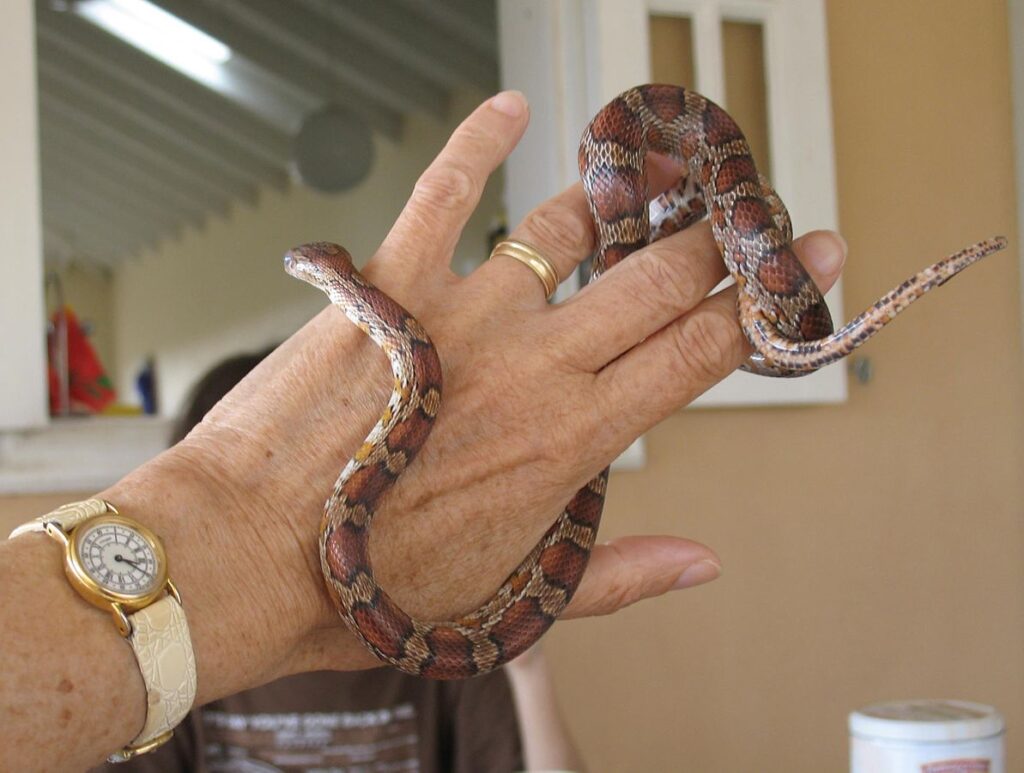
As a pet owner, you have to manage your expectations and understand that owning a snake is different from a dog, which is naturally more affectionate. Regardless of the science, having a pet snake still has its rewards, such as watching your snake grow and thrive in captivity with you by its side.
Notes to Remember
Now that you’ve brushed up on your knowledge and are ready to choose your pet snake, here are some considerations you should take in mind upon arriving at the pet store.
It’s best to observe the snake you want from a distance and watch it eat, especially if you’re looking to raise a hatchling. If you want an adult snake as a pet, try asking the shop owner if you can take it out of its tank and handle it to gauge its temperament.
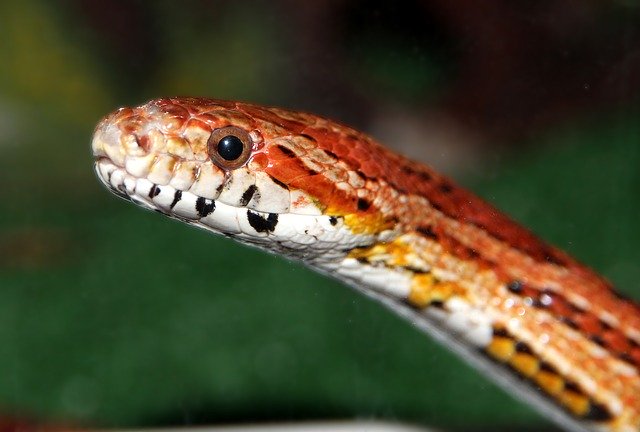
If you have the choice, start with snakes raised in captivity since they are familiar to some level of human contact. According to Laurie Hess, DVM, and Rick Axelson, DVM, “Young, captive-raised animals make the best pets. Older, imported, wild-caught animals are harder to tame, may harbor more internal and external parasites, and often suffer illness from the stress in captivity.”
Once you buy a corn snake, it’s your responsibility to give it the care it deserves. This includes proper knowledge of the costs of raising a snake. Your pet snake can grow and live a long and healthy life in captive environments with appropriate care and guidance.
Frequently Asked Questions
Are corn snakes venomous?
No. Like pythons, corn snakes wrap themselves tightly around their prey to kill it. If they feel too stressed or if you have the smell of food on your hands, there’s a small possibility that your pet may lash out and bite.
Do corn snake bites hurt?
On the rare occasion that your corn snake bites, small ones are not likely to cause any pain, but a bite from an adult may sometimes draw tiny pinpricks of blood. In this case, it’s best to rinse with water and soap then apply an antiseptic ointment.
To prevent accidents, it’s best to handle your snake for the prescribed length of time. Put it down sooner when it’s in visible distress, and wash your hands thoroughly after preparing its food.
Do corn snakes like being petted?
No. You should keep to the prescribed time limit when handling any snake since excessive contact tends to make your pet uncomfortable and may increase their stress levels. Even snakes that are in captivity do not enjoy pets.
Which snake is better as a pet – a male or female?
It depends on the situation. Males tend to get aggressive during mating season to show dominance, while females sometimes become more defensive after laying eggs.
This breed is usually laid-back, so sex isn’t that big a factor so much so than the snake’s personality.
Can I keep my snake with another in the same enclosure?
Snakes aren’t social creatures, and pet owners should not keep two snakes in the same tank. On its own, a corn snake is generally docile, but making it share the same space with another snake increases the risk of disease, aggressive behavior due to competition for resources, ill-timed mating, and even cannibalism. However, it’s possible to keep two female corn snakes in one tank. But two males or one male and female is a recipe for disaster.
Where can I find an escaped snake?
When you can’t see your pet snake in their tank, don’t panic! Ensure that the tank is empty before you exhaust all possible hiding spots and crevices where your snake may be hiding. Go over, under, behind, and on top of objects in your house and check toilets, washing machines, and drains. Snakes that escaped tend to hide close to their tank. Some owners have even reported snakes willingly showing up after a few days once the snake gets hungry, tired, or cold.
Where can I keep snakes as pets?
Different states have different laws for snake ownership with some banning pet snakes outright, some requiring permits, or some allowing only non-venomous snakes.
What are the disadvantages of owning a snake?
There’s a rare chance that your own snake will bite you. Although, we do know that their bites are non-venomous and do not cause serious harm.
There’s another risk with having snakes and reptiles as pets since they may carry salmonella bacteria in their intestines. The bacteria that spread through your pet’s droppings can contaminate their habitat and infect the owner. Both live and frozen rodents used to feed your snake can also carry salmonella.
Remember to wash your hands thoroughly before and after handling your pet snake and its equipment to reduce the risk of infection.
How do snakes show affection?
If your reference for affection from pets are cats or dogs, you must be prepared not to expect the same thing from snakes. They do show affection, but in a very different way from what you might be used to. Brad Moon affirms this, saying that snakes are more likely to simply familiarize themselves with their owner’s smell and climb on them.
Is a corn snake a good pet?

